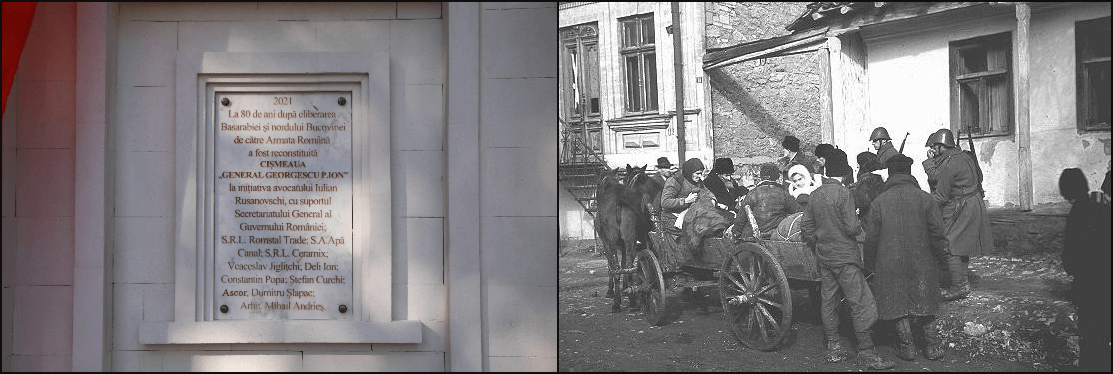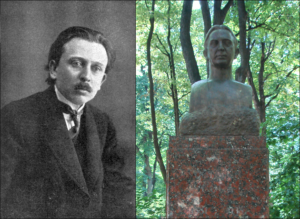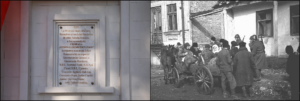Nazi collaborator monuments in Moldova
Octavian Goga, who enacted laws stripping a third of Romania’s Jews of citizenship, has a bust in Chisinau

Left: plaque on monument in Valea Morilor Park, Chisinau (Facebook). Right: deportation of Jews from Kishinev (now called Chisinau), October 28, 1941 (United States Holocaust Memorial Museum). Image by Forward collage
This list is part of an ongoing investigative project the Forward first published in January 2021 documenting hundreds of monuments around the world to people involved in the Holocaust. We are continuing to update each country’s list; if you know of any not included here, or of statues that have been removed or streets renamed, please email [email protected], subject line: Nazi monument project.

Chisinau and two other locales — The Alley of Classics promenade in Stephen the Great Park has a bust to the poet Octavian Goga (1881–1938). Goga served as Romania’s prime minister; a fascist and consummate hater of Jews, he had cofounded the National Christian Party, which had a swastika in its logo and engaged in antisemitic violence. As prime minister of Romania, Goga enacted laws stripping a third of his country’s Jews of citizenship. “Briefly, we have far too many Jews,” he told the New York Times before passing the laws. At least 12,000 Roma and 280,000–380,000 Romanian and Ukrainian Jews were murdered during the Holocaust in Romania.
Goga also has a street in Chisinau as well as in Glodeni and Hînceşti. See the Romania section for more Goga honors.

Chisinau — A plaque commemorating “the liberation of Bessarabia and Northern Bukovina by the Romanian army,” in Chisinau’s Valea Morilor Park. In 1940, the Soviet Union forcibly annexed the regions of Bessarabia and Northern Bukovina from Romania. The Soviet takeover didn’t last long – a year later, Romania invaded the USSR alongside Nazi Germany, recapturing Bessarabia and Northern Bukovina. The plaque in Chisinau celebrates that recapture.
The problem is that in the process of “liberating” Bessarabia and Northern Bukovina, Romania slaughtered the regions’ Jews and Roma. The fascist dictator Ion Antonescu ordered the immediate “cleansing” of Jews: Romanian forces working alongside Nazi death squads complied, murdering 150,000 Jews in Bessarabia alone within one month of the invasion. The rest of the regions’ Jews were imprisoned in ghettos and forced on death marches to Transnistria, where the survivors were promptly murdered. In 1940, Bessarabia had 200,000 Jews; by May 1942, there were 227 left. That’s what the Romanian “liberators” being honored by Chisinau’s plaque did to Bessarabia and Northern Bukovina.
The plaque, which was unveiled in October 2021, is part of a larger WWI monument that was restored with the support of the Romanian government. (The original monument commemorates Romanian victories in WWI; only the plaque glorifies WWII butchery.) High level functionaries including the Romanian ambassador to Moldova attended the unveiling ceremony. Above right, Romanian soldiers deporting the Jews of Chisinau, October 1941.
For more on the Holocaust in the region, see Yad Vashem (witness and survivor testimonies), the U.S. Holocaust Memorial Museum and Radio Free Europe.
The Forward is free to read, but it isn’t free to produce

I hope you appreciated this article. Before you go, I’d like to ask you to please support the Forward.
Now more than ever, American Jews need independent news they can trust, with reporting driven by truth, not ideology. We serve you, not any ideological agenda.
At a time when other newsrooms are closing or cutting back, the Forward has removed its paywall and invested additional resources to report on the ground from Israel and around the U.S. on the impact of the war, rising antisemitism and polarized discourse.
This is a great time to support independent Jewish journalism you rely on. Make a gift today!
— Rachel Fishman Feddersen, Publisher and CEO
Support our mission to tell the Jewish story fully and fairly.
Most Popular
- 1

Fast Forward Ye debuts ‘Heil Hitler’ music video that includes a sample of a Hitler speech
- 2

Opinion It looks like Israel totally underestimated Trump
- 3

Culture Cardinals are Catholic, not Jewish — so why do they all wear yarmulkes?
- 4

Fast Forward Student suspended for ‘F— the Jews’ video defends himself on antisemitic podcast
In Case You Missed It
-

Culture Should Diaspora Jews be buried in Israel? A rabbi responds
-

Fast Forward In first Sunday address, Pope Leo XIV calls for ceasefire in Gaza, release of hostages
-

Fast Forward Huckabee denies rift between Netanyahu and Trump as US actions in Middle East appear to leave out Israel
-

Fast Forward Federal security grants to synagogues are resuming after two-month Trump freeze
-
Shop the Forward Store
100% of profits support our journalism
Republish This Story
Please read before republishing
We’re happy to make this story available to republish for free, unless it originated with JTA, Haaretz or another publication (as indicated on the article) and as long as you follow our guidelines.
You must comply with the following:
- Credit the Forward
- Retain our pixel
- Preserve our canonical link in Google search
- Add a noindex tag in Google search
See our full guidelines for more information, and this guide for detail about canonical URLs.
To republish, copy the HTML by clicking on the yellow button to the right; it includes our tracking pixel, all paragraph styles and hyperlinks, the author byline and credit to the Forward. It does not include images; to avoid copyright violations, you must add them manually, following our guidelines. Please email us at [email protected], subject line “republish,” with any questions or to let us know what stories you’re picking up.
















